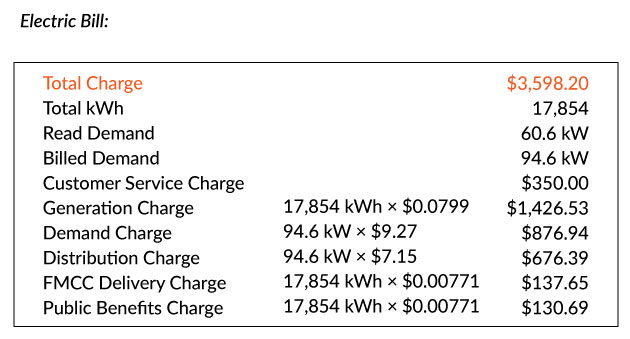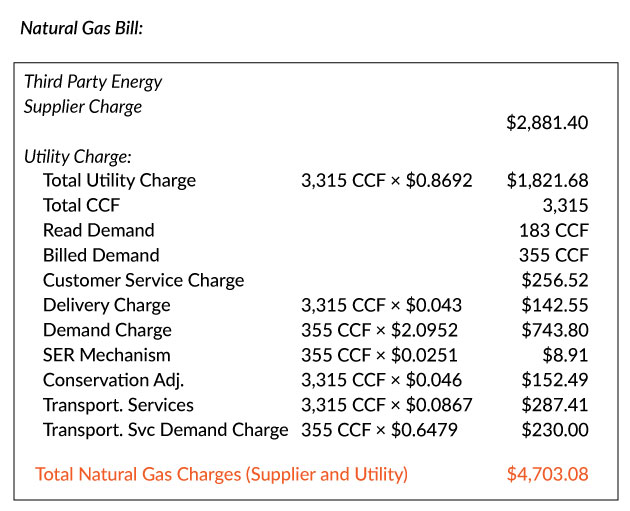
SRS Blog
Building energy efficiency insights from the innovators behind EPICDevil is in the Details: Understanding Utility Bills for Energy Cost Savings Analysis
Utility bills are built around tariffs that define the billing structure, rate schedule and other charges. The rate schedule applicable to a commercial building will impact the energy cost savings resulting from energy efficiency improvements that reduce electricity (kWh) and/or natural gas (therms or CCF) consumption, and electricity (kW) and/or natural gas demand (therms or CCF). Failure to understand the intricacies of the applicable tariff can result in an energy efficiency upgrade project misrepresented by poorly calculated energy cost savings.
Utility Electricity Bills
Most commercial electricity bills include several of the following components:
- Customer charge (a fixed cost each month)
- Energy consumption (also called energy use) charge (kWh)
- Energy distribution/demand charge (kW)
- Fuel adjustment charge
- Surcharges, such as environmental, regulatory, etc.
- Sales tax (if applicable).
Electricity consumption (use) charges typically rely on flat, tiered or time-of-use billing. For flat billing there is only one rate for all electricity consumption, although some utilities may charge a different rate during peak usage periods, such as in the summer. With tiered billing, there are two or more rates, with different rates typically associated with different consumption amounts. For example, the first several hundred kWh may be billed at one rate and the next several hundred kWh billed at another rate, and so on. There also may be seasonal variations for these tiers. With time-of-use billing, there are two or more rates depending on the time of day the electricity is consumed. A utility will typically define on-peak and off-peak times based on how much demand may occur during those times. Customers are charged a higher rate during on-peak times.
Demand charge billing results in the customer paying for the highest power load reached (typically over the previous twelve months) – the “ratchet” peak demand (or Billed Demand). Actual peak demand (or Read demand) is defined as the highest average load during a peak demand interval (typically 15 minutes) in each billing cycle. To better understand the difference between consumption (kWh) and demand (kW), consider an analogy involving filling a swimming pool. The volume of water would be akin to the consumption (kWh) charge, while the flow rate out of the hose would be analogous to the demand (kW) charge. Today, the demand charge portion of the bill often exceeds the electricity consumption portion of the bill.
Even more important is the fact that many tariffs often contain a ratchet clause that imposes a minimum demand charge throughout the year based on the highest peak demand reached over the prior year. The ratchet clause is a common way for utilities to recoup the significant short- term expenses they incur during the summer months when they must supply more power due to the elevated demand resulting from an increased air conditioning need.
Ratcheted demand charges are commonly determined as follows. The utility records when you establish a “new high” peak demand in any 15-minute period (although some utilities use 30-minute or 60-minute periods). Assuming the ratchet is 100% (although it may be lower), then going forward for the next twelve months the utility sets the minimum Billed Demand equal to 100% of the maximum recorded peak kW. Even if you make energy efficiency improvements such as the addition of LED lighting that reduces both the kWh energy consumption and kW demand, for the next twelve months you will continue to be billed at 100% of your previously recorded (pre-LED) peak demand. Your utility bill will typically identify Read Demand and Billed Demand, but your charge will be based on Billed Demand (ratchet). Hence, if you projected a demand cost savings in the year following the LED upgrade, unless the utility tariff indicated otherwise this savings would not be realized by the building owner until after the ratchet expires.
Utility Natural Gas Bills
Most commercial natural gas bills include several of the following components:
- Customer charge (a fixed cost each month)
- Consumption (also called delivery) charge (therms or CCF)
- Demand charge (therms or CCF)
- Surcharges, such as for energy conservation funding, etc.
- Sales tax (if applicable).
What holds for utility electricity bills also holds for most utility gas bills. There are natural gas consumption or use (therms or CCF) charges and natural gas demand (CCF or therms) charges. Just like electricity rates, when ratchet provisions exist you will see Read Demand and Billed Demand on the utility bill.
Using Utility Bills in Energy Cost Savings Analysis
Assume an energy efficiency project is proposed that will save both electricity and natural gas. Once the energy consumption (kWh) and demand (kW) savings are calculated, the expected energy cost savings needs to be assessed. Interestingly, building owner clients are typically more interested in the cost savings associated with a proposed energy improvement project – and this calculation can often be misrepresented by poor application of the utility rate to the projected energy consumption and demand savings.
An example will provide further clarification. Assume a building’s electricity bill and natural gas bill in a monthly billing period are as follows.


One of the more common errors that exists in estimating energy cost savings involves using a “blended rate” for both electricity and natural gas. The blended electricity rate entails dividing the total electricity bill by the total kWh of electricity consumed in that billing period. The blended natural gas rate entails dividing the total natural gas bill by the total CCF of gas consumed in that billing period. These blended rate calculations have been done both using annual energy consumption/cost figures or figures from the most recent month. The blended $/kWh rate would then be multiplied by the projected kWhs saved to project the electricity cost savings and the blended $/CCF would then be multiplied by the projected CCFs saved to project the natural gas cost savings. Unfortunately, this approach can provide a grossly inaccurate estimate of the energy cost savings, especially for improvements that do not result in any peak demand savings.
Using the sample electricity bill above, the monthly blended electricity rate would be $3,598.20 / 17,854 kWh or $0.2015/kWh. The correct electricity rate, however, should instead be based on only those items in the bill that are calculated using kWh. For the sample bill, this would be $0.09493/kWh. Hence the blended rate error would result in an electricity cost savings estimate more than twice what it should be!
Furthermore, the fact that there is a Billed Demand and a Read Demand in this example indicates the existence of a ratchet provision in the electricity rate schedule. Hence, even though there are kW demand savings, in the first year no associated cost savings would be realized because the utility would continue billing at the Billed Demand level which would be equivalent to the highest (peak) demand in the prior twelve months.
Similarly, using the total natural gas charges, the monthly blended rate would be $4,703.08 for 3,315 CCF or $1.4187/CCF. However, the correct natural gas rate to determine the value of gas consumption savings should be $3,463.85 / 3,315 CCF or $1.045/CCF. Hence the blended rate error would result in a natural gas cost savings estimate 36% higher than what it should be! Again, the fact that there is a Billed Demand and a Read Demand in this example indicates the existence of a ratchet provision in the rate schedule as well. Hence, even though there are CCF demand savings, in the first year no associated cost savings would be realized because the utility would continue billing at the Billed Demand level which would be the highest (peak) demand in the prior twelve months.
Conclusions
- It is critical to understand utility rate schedules prior to calculating energy cost savings. Review recent utility bills for the owner’s building where energy efficiency improvements are being proposed (for at least a twelve-month period) and review published details about the applicable utility tariff, especially the existence of ratchet provisions and any exceptions to the ratchet (such as may exist for renewable energy systems).
- Refrain from using blended rates to assess the energy cost savings.
- To determine the $/kWh and $/CCF rates for use in assessing energy cost savings, review the respective utility bills and add up all the charges that are specifically based on kWh and CCF. These charges should then be divided by the respective kWh and CCF consumed to determine the appropriate rates. Also, to determine demand charges, add up all the costs based on kW for electricity demand ($/kW) and all the costs based upon demand/delivery CCF for natural gas demand ($/demand CCF). If you notice that Billed Demand does not change from month to month, this indicates that there is ratcheting which should be factored into the projected cost savings, e.g., there may be no demand cost savings in the first year.
- When combined heat and power (CHP) cogeneration systems are proposed, careful attention should be given to expected operation over the year, including anticipated downtime. This can have an impact on potential demand cost savings. If a unit trips out or shuts down for maintenance, ratchet provisions, if applicable, may kick in and continue for the next twelve months even though there would be significant demand reduction while the unit is operating.
- Unless a proposed energy efficiency improvement can be shown to reduce its demand all the time, it would be best to calculate energy cost savings conservatively, i.e., assuming no demand savings. This is particularly true for solar PV and wind systems without energy storage capability. Even if the improvement does reduce demand all the time, check the utility tariff for the existence of potential ratchet provisions that can reduce or eliminate first year projected savings.
Fortunately, a new generation of software, data and predictive analytic solutions are emerging specifically designed to empower project developers and energy efficiency contractors to input both energy consumption and demand charges extracted from a building’s utility bills. This approach, coupled with a thorough understanding of energy charges and utility tariffs, should help to improve energy cost savings projections.
To learn more about how energy efficiency professionals are successfully meeting these challenges with SRS’s latest innovation: The Energy Performance Improvement Calculator (EPICTM), visit SRSworx.com.

About the Author
Anthony J. Buonicore is Director of Engineering at Sustainable Real Estate Solutions. Mr. Buonicore is a licensed professional engineer with almost 50 years' experience in the commercial real estate energy and environmental industry. He may be contacted through our Contact page.

